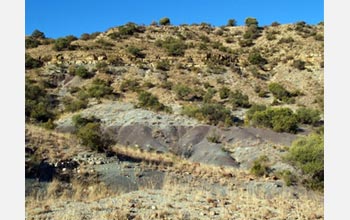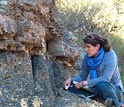News Release 09-031
Geologic Findings Undermine Theories of Permian Mass Extinction Timing
South Africa's Karoo Basin Shows No Indication of "Boundary Event Rock Bed"

The Karoo Basin in South Africa holds the world's best record of the Permian Mass Extinction.
March 2, 2009
This material is available primarily for archival purposes. Telephone numbers or other contact information may be out of date; please see current contact information at media contacts.
New scientific findings by geologist Robert Gastaldo of Colby College in Waterville, Maine, and colleagues call into question popular theories about the largest mass extinction in Earth's history.
A paper reporting the results by Gastaldo, South African scientist Johann Neveling, and two 2008 Colby undergraduate students, C. Kittinger "Kit" Clark and Sophie Newbury, appears in the March 2009 issue of GEOLOGY.
Tens of millions of years before dinosaurs roamed Earth, their ancestors were all but eliminated in a catastrophic event called the Permian Mass Extinction. The Permian period extended from 299 to 252.6 million years ago.
"The Permian-Triassic boundary marks the greatest extinction event in Earth's history, with significant loss of biodiversity both on land and in the oceans," says H. Richard Lane, a paleontologist and program director in the National Science Foundation (NSF)'s Division of Earth Sciences, which funded the research.
"Until this study, it was believed that the event was marked by unique rocks traceable across southern hemisphere continents. This research calls into question whether the extinction event is actually constrained in the geologic record on land."
Ideas about the event's impact on land animals and plants are based largely on records in the Karoo Basin in central South Africa, where the best fossil records from that time are found, and where Gastaldo and his students have worked since 2003 with funding from NSF.
Earlier analysis of the rock record by other scientists working in South Africa led them to hypothesize about the nature, scope and timing of the mass die-off of prehistoric amphibians and reptiles.
They claimed that one unique sedimentary layer in the Karoo Basin overlies fossils of the last reptiles of the Permian period (synapsids, including the genus Dicynodon).
This layer has been dubbed "the dead zone" because of its absence of fossil remains.
This dead zone was thought to be synchronous in time and space, marking the event across southern Africa and as far away as Antarctica.
Now Gastaldo and co-authors report that they have found conflicting stratigraphic evidence in the Karoo Basin.
They discovered that this dead zone layer, or event bed, is not found at the same physical position in the rock record at all places, even across the immediate landscape where it was first described.
As such, it is not a reliable marker of the mass extinction of terrestrial animals, Gastaldo says.
Within one kilometer, just across the valley from the site where it was first described, the layer occurs lower in the rock record by eight meters (more than 25 feet).
Several hundred kilometers away, at Lootsberg Pass, reptile fossils occur above the layer rather than below it, further undermining the credibility of the zone as a marker of the mass extinction of animals at the end of the Permian.
Gastaldo says that the research proves that "there is no evidence to support a terminal extinction event in the record of the Karoo Basin, based on the criterion of an unique event bed or dead zone."
-NSF-
-
Scientist Sophie Newbury studies the "dead zone," a rock layer in Karoo Basin.
Credit and Larger Version
Media Contacts
Cheryl Dybas, NSF, (703) 292-7734, email: cdybas@nsf.gov
Steve Collins, Colby College, (207) 859-4352, email: sbcollin@colby.edu
The U.S. National Science Foundation propels the nation forward by advancing fundamental research in all fields of science and engineering. NSF supports research and people by providing facilities, instruments and funding to support their ingenuity and sustain the U.S. as a global leader in research and innovation. With a fiscal year 2023 budget of $9.5 billion, NSF funds reach all 50 states through grants to nearly 2,000 colleges, universities and institutions. Each year, NSF receives more than 40,000 competitive proposals and makes about 11,000 new awards. Those awards include support for cooperative research with industry, Arctic and Antarctic research and operations, and U.S. participation in international scientific efforts.
Connect with us online
NSF website: nsf.gov
NSF News: nsf.gov/news
For News Media: nsf.gov/news/newsroom
Statistics: nsf.gov/statistics/
Awards database: nsf.gov/awardsearch/
Follow us on social
Twitter: twitter.com/NSF
Facebook: facebook.com/US.NSF
Instagram: instagram.com/nsfgov



